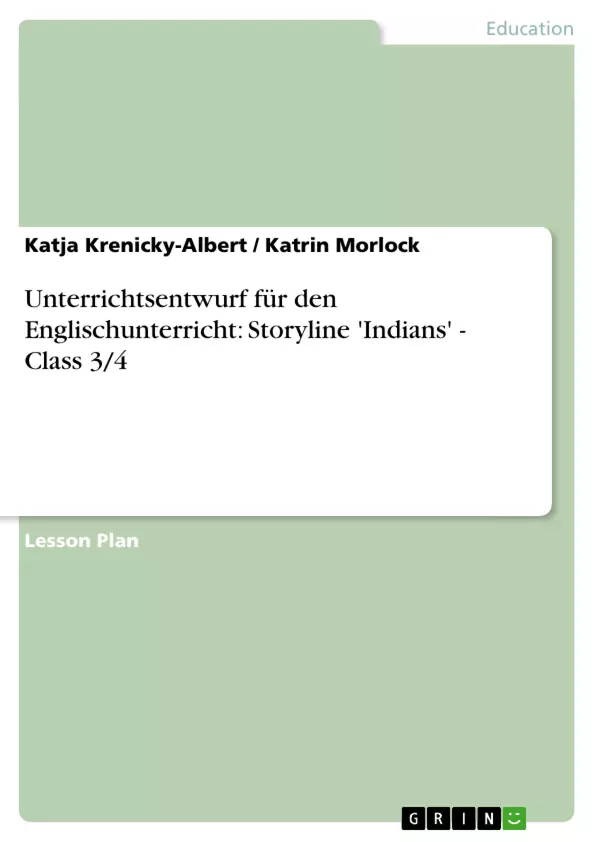The content of the following Storyline project conceived around the topic 'Indians' respectively Native Americans2 is aimed to introduce children into Native American culture. In the context of regional studies the children are acquainted with various interesting aspects of Indian lives, of their habits and living conditions. Although in primary English a detailed discussion and reflection on the dramatic historical and contemporary Native American problems (the conflict with the ‘White Man’, the life in reservations, the danger of ‘cultural extinction’ etc.) is hardly possible, the occupation with more ‘positive’ aspects of the topic may provide a more realistic image of Native American culture than offered by commercial media thus making a first decisive step to counter the arising of rigid, prejudiced, stereotype-based attitudes that even a majority of adults have today.
The widespread stereotypical image of ‘Indians’ in movies (e.g. Winnetou), books or comics is an exaggerated portrayal of the so called Prairie and Plains Indians. However, there were other cultures and over 500 different tribes living together on the huge continent. The focus of this project is on three major Indian cultures: The Prairie and Plains Indians, the Forest Indians, and the Pueblo Indians.
Inhaltsverzeichnis (Table of Contents)
- Background Information about the Topic
- Native Americans
- Three Major Native American Cultures
- The Prairie and Plains Indians
- The Forest Indians
- The Pueblo-Indians
- Common Features of Native American Cultures
- A Creative and Imaginative Way of Living
- Manitou, Beliefs and Ceremonies
- Didactic Considerations
- Relation to the Curriculum
- Relation to the Children's Lives
- Learning Objectives
- Intercultural Competence
- Content Objectives/ Regional Studies
- Language Objectives
- Language Learning Strategies
- Social Competence
- Methodical Design - Teacher's Notes
- EPISODE 1: Indian Tribes & Indian Homes
- EPISODE 2: The Characters
- EPISODE 3: The Thunderstorm
- EPISODE 4: The Trade and a Message from Manitou
- EPISODE 5: A Festival for Manitou
Zielsetzung und Themenschwerpunkte (Objectives and Key Themes)
This Storyline project aims to introduce children to Native American culture. It focuses on regional studies, acquainting children with various interesting aspects of Indian lives, habits, and living conditions. While a detailed discussion of historical and contemporary Native American problems is not possible in primary English, this project aims to provide a more realistic image of Native American culture than commercial media, countering stereotypical and prejudiced attitudes. The focus is on three major Indian cultures: The Prairie and Plains Indians, the Forest Indians, and the Pueblo Indians.
- Introduction to Native American Culture
- Focus on Regional Studies and Cultural Aspects
- Countering Stereotypes and Prejudices
- Exploration of Three Major Indian Cultures
- Emphasis on Creativity and Imagination in Native American Cultures
Zusammenfassung der Kapitel (Chapter Summaries)
The first chapter provides background information about Native Americans, focusing on the distinction between the term 'Indians' and 'Native Americans' and emphasizing the importance of countering stereotypical representations. It then introduces three major Native American cultures: the Prairie and Plains Indians, the Forest Indians, and the Pueblo Indians, outlining their geographical locations, lifestyles, housing, and key cultural aspects. Chapter two discusses didactic considerations, including the relation of the project to the curriculum, its relevance to children's lives, and learning objectives. This chapter outlines the goals of promoting intercultural competence, addressing regional studies, developing language skills, and fostering social competence. The third chapter, "Methodical Design - Teacher's Notes," presents a detailed plan for implementing the project, outlining five episodes focusing on Indian tribes and homes, characters, a thunderstorm, trade, and a festival for Manitou.
Schlüsselwörter (Keywords)
Native Americans, Indian culture, regional studies, intercultural competence, stereotypes, prejudices, Prairie and Plains Indians, Forest Indians, Pueblo Indians, creativity, imagination, Manitou, beliefs, ceremonies, storytelling, cultural understanding, teaching resources, primary English.
- Quote paper
- Katja Krenicky-Albert (Author), Katrin Morlock (Author), 2004, Unterrichtsentwurf für den Englischunterricht: Storyline 'Indians' - Class 3/4, Munich, GRIN Verlag, https://www.grin.com/document/43974



